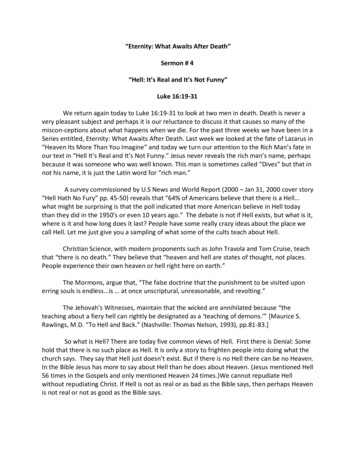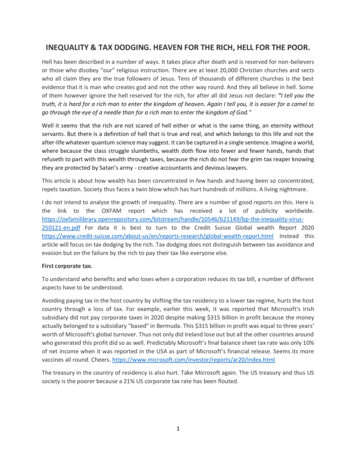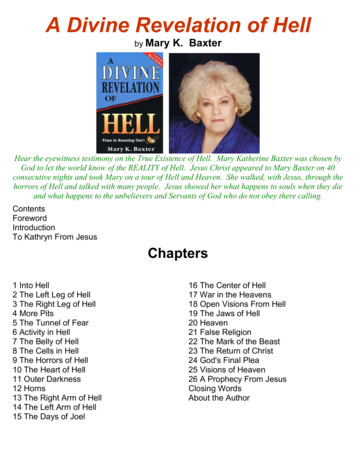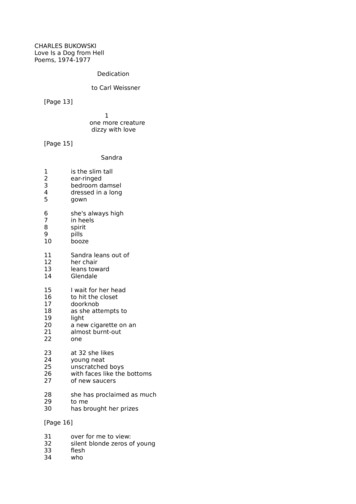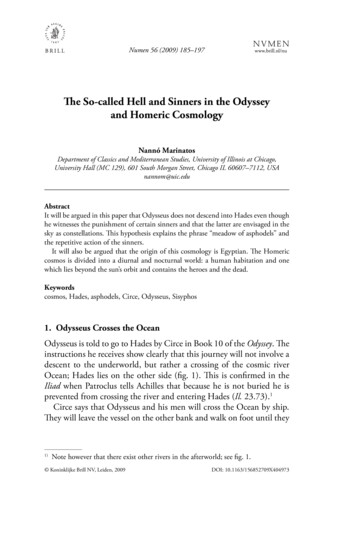
Transcription
Numen 56 (2009) 185–197www.brill.nl/nuThe So-called Hell and Sinners in the Odysseyand Homeric CosmologyNannó MarinatosDepartment of Classics and Mediterranean Studies, University of Illinois at Chicago,University Hall (MC 129), 601 South Morgan Street, Chicago IL 60607–7112, USAnannom@uic.eduAbstractIt will be argued in this paper that Odysseus does not descend into Hades even thoughhe witnesses the punishment of certain sinners and that the latter are envisaged in thesky as constellations. This hypothesis explains the phrase “meadow of asphodels” andthe repetitive action of the sinners.It will also be argued that the origin of this cosmology is Egyptian. The Homericcosmos is divided into a diurnal and nocturnal world: a human habitation and onewhich lies beyond the sun’s orbit and contains the heroes and the dead.Keywordscosmos, Hades, asphodels, Circe, Odysseus, Sisyphos1. Odysseus Crosses the OceanOdysseus is told to go to Hades by Circe in Book 10 of the Odyssey. Theinstructions he receives show clearly that this journey will not involve adescent to the underworld, but rather a crossing of the cosmic riverOcean; Hades lies on the other side (fig. 1). This is confirmed in theIliad when Patroclus tells Achilles that because he is not buried he isprevented from crossing the river and entering Hades (Il. 23.73).1Circe says that Odysseus and his men will cross the Ocean by ship.They will leave the vessel on the other bank and walk on foot until they1)Note however that there exist other rivers in the afterworld; see fig. 1. Koninklijke Brill NV, Leiden, 2009DOI: 10.1163/156852709X404973
186N. Marinatos / Numen 56 (2009) 185–197Figure 1. The route of Odysseus across the Ocean. (Drawing CatherineChaton)arrive at a spot where a pit is to be dug. Then, they will make sacrificesand invoke the shades.The hero does as he is told by Circe; indeed, one by one the ghostsgather around the pit (11.36). There is an implication that they comefrom underneath by the expression hypex or hypo “from under” (11.37, 57)but their place of origin is far from clear.2All the psychai or eidola are recognized by Odysseus, which is dueto the fact that they are duplicates of what they were in life (cf. alsoIl. 23.104) (Bremmer 1983). However, they do not recognize him. Whyso? It is because they have lost their memory. Circe clearly tells Odysseusthat Teiresias alone has kept his mind, a gift granted to him by Persephone (10.490–95), and it is for this reason that he alone is able torecognize Odysseus even before he drinks blood (11.91).There is a profound insight into the nature of death behind thedescription of these ineffective spirits: Homer is saying that withoutmemory, there is no identity. In consequence, the dead do not and cannot suffer because they have no consciousness. Suffering entails either2)For the vertical dimension of ascent-descent into Hades see West 1997.
N. Marinatos / Numen 56 (2009) 185–197187bodily pain or mental anguish, but these ghosts experience neither ofthese feelings: they are in a state of oblivion.Our first conclusion is that in the Odyssey we find no descent into theunderworld and that although Hades is a sunless world, it is not entirelydark. Rather, it may be described as a place of perpetual dusk and mist(zofos 11.155) containing groves of poplars and meadows of asphodels,and even a city (fig. 1). We also learn that it is the habitat of shadeswithout memory. For the rest, it is not an unpleasant place to be in; noris it horrifying.2. The TransgressorsNow we come to a different issue, which has to do with the categoriesof the dead and their respective location within Hades. In addition tothe shades, Odysseus sees a set of heroes who are not interested in blood,and who do not talk to Odysseus; moreover, they belong to the remotepast, to the generation before the Trojan War.First he sees Minos holding his scepter seated in judgment amongthe dead (11.568). Since Minos is seated, he is not parading like theghosts of the previous section. Then, he sees huge Orion hunting withhis dogs in the meadow of asphodels (11. 573). Orion is not describedas a transgressor in this passage, but elsewhere in the poem it is statedthat he slept with Eos, an act the gods do not approve of (5.274). He isalso considered an ill omen: in the Iliad, the appearance of the starcalled “dog of Orion” does not bode well (Il. 22. 29–300).Next, Odysseus sees Tityos lying on nine pelethra. Since a pelethron isa measure of about a hundred square feet, Tityos must have been enormous. Fixed in the same position, he is eaten by the vultures. An explanation of why he is being punished in eternity is added: he had attemptedto violate Leto (11.580).The next figure is Tantalos standing by a lake from which he cannotget water to quench his thirst. Around him are trees, but he cannot reachtheir fruit (11.581–92). We are not told what sin he had committed.Sisyphos is seen next, holding a huge rock with both hands andpushing it uphill while sweat is pouring down his face (11.593–600).Next, Odysseus sees Heracles, but now a new element is introduced:he is able to have a conversation with him. For this reason Heracles
188N. Marinatos / Numen 56 (2009) 185–197does not belong to the category under discussion; the group ends withSisyphos.The group of the aforementioned four transgressors, plus the judgeMinos, form a distinct unit, which ought to be differentiated from theparade of ghosts. While the latter converse with Odysseus, the transgressors are engaged in repetitive action as though they were fixed forever on a rotating wheel.The question is where does Odysseus see these figures? As we haveseen, he does not move from his position. The puzzle has been noted byimportant scholars, such as U. von Wilamowitz-Moellendorf, and isaddressed anew by Walter Burkert in this issue. W. B. Stanford, in hiscommentary of the Odyssey, suggests that the passage is an interpolation, perhaps from Orphic sources (Stanford 1964:401).Then, there is the question where is the meadow of asphodels in whichOrion and Achilles are located (11.539)? And how come the transgressorOrion is situated in such a meadow of white flowers?3. The Meadow of Asphodels as StarsA crucial clue as to how we may interpret the meadow of asphodels isgiven in the Homeric poems themselves. Orion is a constellation in thesky in both the Odyssey and Iliad (Il. 13.488; Od. 5.274; Il. 21.39).Could it be that all the other transgressors and their judge Minos arevisions seen in the night sky? (I do not count Achilles in this category.)This would explain why they do not converse with Odysseus.There are several reasons why this hypothesis works. First, Plutarchidentifies Orion with the Egyptian constellations of Horus and Seth(De Iside et Osiride, 21–22), and although Plutarch lived much laterthan the poet of Odyssey, his testimony is useful because he links astralOrion with Egyptian mythology. Second, the sinners repeat their actionin perpetuity: Orion keeps hunting with his dogs; Sisyphos keeps pushing the stone; Tantalos attempts to drink from the lake. Third, Odysseuscannot talk to these heroes because they are in the sky; interaction withthem is not possible. However, he does see them clearly in their trueform, as though he had been initiated into some truth.Consider also the Bacchic tablet from Thurii where the deceased happilydeclares: “I have flown out of the heavy difficult circle (stephanos)” (Graf
N. Marinatos / Numen 56 (2009) 185–197189and Johnston 2007, no. 5, 12–13). The circle implies repetitive action,which the soul wants to escape, and it suits the constellation theorywell. Finally there is a passage in the Iliad referring to constellationsthat never set and therefore never bathe in the Ocean. Note that Orionis one of them. The text implies that they are envisaged as a circle inheaven (ouranos estephanotai, 18.486–89).Combining all the above and following the hint by Plutarch, weturn to Egypt to explore the tradition of mythical constellations inthe afterlife.First of all it is important to start with the term for the beyond, duatin Egyptian. Its location (under the earth or inside the vault of heaven)was a matter of speculation and varied from period to period; moreoverthere were differences of opinion even within the same period.3 Forexample, during the Pyramid age it was imagined to be in the sky. ThePyramid texts attest to the fact that the pharaoh ascended to the sky orflew to it after death and became a star, thus integrating himself withthe gods of the duat. Some spells specify that he would rise with Horus(Allen 2002; Hornung 1999:5–6). One spell, from the Pyramid ofUnas, states that the pharaoh will travel through the firmament in thedarkness, and he will rise on the horizon where he is radiant.4According to a variant cosmological model, also stemming from thePyramid Texts of the Old Kingdom, the king was identified with theimperishable circumpolar stars that never set, the ones “that know nodestruction.”5 In short, there existed a tradition to the effect that thenight sky is the beyond, and that the dead pharaoh became a star.There are other features of Egyptian netherworld beliefs that are relevant to the understanding of Hades. An entire landscape in the skywas envisioned by the Egyptians, including islands, lakes, marshes andrivers. In the Pyramid texts, for example, lakes and fields of rushes aresituated in the nocturnal heaven whereas similar landscapes are mentioned in the New Kingdom papyri.6 The fields of reeds are strongly3)An excellent analysis of Egyptian cosmology can be found in Allen 1988.Simpson et al. 2003:250 (spell 214, lines 154, 158).5)Allen 2002:63; Simpson et al. 2003: utterances 214, 217 (pp. 248–49); 412 (p. 254;422 (p. 255).6)Simpson et al. 2003:256–57 (spell 473, lines 926, 930, 936); Hornung 1999:124–30.4)
190N. Marinatos / Numen 56 (2009) 185–197reminiscent of the Homeric meadow of asphodels, which reinforces thehypothesis that the asphodels are the stars of the night sky.In the New Kingdom, especially from the 18th dynasty onwards,theories about the cosmology and topography of the afterworld weresummarized in the Book of Day, Book of Night, Book of Gates, Amduat,etc. They are attested in papyri, sarcophagi and royal tombs and consistof closely knit texts and images. The main theme is the journey of thesun god in the beyond hour by hour subdivided into twelve scenes, eachreflecting one hour of the night (Hornung 1982:227–30; 1999:32–152).As the sun travels from the diurnal to the nocturnal universe, he reachesthe depths of the beyond, becomes a corpse and eventually, as the nightproceeds, he becomes regenerated and re-emerges stronger. Finally, heis reborn rejuvenated in the morning. For our purposes one question isimportant: where are the depths of the cosmos in which the sun hidesat night? An intuitive answer is that they are below the earth, but this isnot to be taken for granted. The Egyptians did conceive of the duateither below or in the nocturnal sky, as shown above. And becauseEgyptians had a way of turning conceptual models into images, theypictured the sky as the female goddess Hathor or Nut. They conceivedof her in either an anthropomorphic form or as a cow, and they imaginedthe sun traveling inside her body. The point is that the sun was hiddenfrom view at night even though he was in the sky (Hornung 1999:116–35,fig. 72; Allen 1988).Sometimes Nut is split into a double figure, two naked women backto back. For example, the decorated ceilings of the royal tombs ofRamses IV and VI had a double image of Nut. In her capacity as thenight sky, Nut swallowed the sun and gave birth to him at dawn in theform of a scarab (Hornung 1999:112–25). The dual sky, or dual Nut isstunningly echoed in the Iliad when heaven is described twice as theday and night sky: “under the sun and [under] the starry sky” (Il. 4.44).According to this definition, what is essential about Hades is that thesun does not shine there (see figs. 1 and 4).4. The Sinners Parade During the Hours of the NightAnother aspect of Egyptian afterworld belief may be helpful to theunderstanding of the passage on the sinners in the Odyssey. The hypo-
N. Marinatos / Numen 56 (2009) 185–197191thetical visitor of an Egyptian royal tomb, such as the one of Seti I,Ramses IV or Ramses VI, would witness the journey to the afterworldas a succession of scenes. As we noted above, each scene depicted a particular hour of the night.In the tomb of Seti I, for example, Osiris the judge appears in thescene depicting the eighth hour; the blessed and damned appear in thefollowing hours; the blessed alone appear in the tenth hour (Hornung1997:125). In the tomb of Haremhab, Osiris is depicted as receivingthe blessed dead in the 5th hour (fig. 2).7The succession of scenes with the judge coming first and the sinnersand blessed appearing subsequently would fit very well the descriptionin the Odyssey. Odysseus first sees Minos (who corresponds to Osiris),then the damned and finally Heracles. The latter may be considered a“blessed dead” since he was the model initiate of the Eleusinian cult.Also very compatible with Egyptian beliefs is the description ofTantalos who is close to a lake from which he cannot drink. Thisstrongly evokes Egyptian New Kingdom texts and vignettes from funerary papyri showing the deceased drinking greedily from a lake to refreshFigure 2. Nut from the Tomb of Ramses VI: Hornung 1999:113, fig. 63.7)Book of Gates: Hornung 1999:62–63, figs. 29, 34.
192N. Marinatos / Numen 56 (2009) 185–197his soul. Water revives the dead (Burkert 2004:87–87; Hornung 1999:128–30).8 The Tantalos scene is evocative also of inscribed Greek Bacchic lamellae. On several specimens from Eleutherna Crete, the deceaseddemands water because he otherwise will perish: “I am parched withthirst and am dying; but grant me to drink.”9 Behind all these texts andimages lies the idea that water is essential to preserve the dead and especially their memory.Another lamella from Pharsalos, Thessaly, dated to c. 350–300, linksthe afterworld with stars. The deceased is instructed to say the wholeentire truth: “I am a child of earth and starry sky. My name is Starry(asterios).”10 Similar expressions are found many times “I am the son ofearth and starry sky.”11 Last but not least, Plutarch clearly states that theconstellations in the sky are souls (psychai) (De Iside 21).Thus, there are quite a few arguments to the effect that stars and thestarry sky afford a glimpse of the beyond, the sphere of the cosmos thatcontains both the transgressors and those who are blessed. Even oneof the Pythagorean riddles might find its explanation with this theory.One of the akousmata poses the question “what are the isles of the blest?”The answer is: “Sun and moon.”12 That the isles of the blessed are heavenlybodies in the sky is a counter-intuitive statement, but it makes sense ifwe adopt the hypothesis I have here suggested.Finally, we must consider the testimony of Herodotus, who says thatOrphic and Bacchic rituals are in reality Pythagorean and Egyptian(2.81.2). Although the exact relationship of these religious groups isdisputed by scholars, it is clear that Herodotus thinks that they wererelated to each other and indebted to Egypt (Riedweg 2002:76–77;Huffman 2007:62–68).I suggest here that Egyptian theology had found its way into Greekcosmology and metaphysics of the Archaic period. This is, historically8)Note that in the tomb of Seti I, the visitor would see the lake of fire from which theblessed dead are provisioned but whose waters are flames for the damned: Hornung1999:60.9)Graf and Johnston 2007, nos. 10–14, 20–25; Merkelbach 1999; Tzifopoulos 2007.10)Graf and Johnston 2007, no. 25, 34–35.11)Graf and Johnston 2007, nos. 8, 10–14,16,18,25. On the Pelinna tablet (no. 26a–b Graf and Johnston), the deceased is a bull or ram which falls into milk. This wouldmake sense if the milk refers to the Milky Way, namely the celestial Nile.12)Riedweg 2002:99–100; West 1971:215–216; Huffman 2008:42.
N. Marinatos / Numen 56 (2009) 185–197193speaking, a highly plausible scenario. Since the seventh century, theGreeks had been serving as mercenaries in Egypt and had settled theirown colony at Naukratis (Burkert 2004:71–98). And these very Egyptian beliefs continued into the Ptolemaic period as the astronomicalceiling of the temple of Hathor at Denderah testifies (Wilkinson 1991).The divine figures depicted in the ceiling of this temple are constellations: Horus and his mother Isis/Taweret maintain the order of thecosmos by anchoring evil forces such as the constellation mskt.5. The Absence of the Sun in HadesIt has been suggested here that Hades corresponds to the nocturnal universe and that this fits reasonably well with Egyptian theology, accordingto which the sun was weak and finally became a corpse in the duat.There is a difference, however, between Egyptian and Homeric cosmology: in the epics, the sun is not only weak in the beyond, he does notreach Hades at all (Od. 12.377–88). If so, where does he go at night?To answer this question we must investigate the location of Circe’sisland because it furnishes an invaluable clue as regards the sun’s course.Odysseus must reach this island before he crosses the Ocean to thenetherworld, but, for reasons that are never explicitly stated in the text,he must return there before he can go on with his journey. This detailshows that the island of Circe is an interface between the inhabitedworld and Hades.It is further clear from the text that the island is located at the edge ofthe inhabited world. Odysseus is disorientated when he is there becausehe cannot discern where the sun rises and where it sets. “My friends”, hesays, “we do not know where East is, nor where the bright sun goes downunder the earth” (Od. 10.190–92; trans. Rieu). It follows from this passage that Odysseus cannot tell east and west apart. I take this to meanthat he is very close to the end of the sun’s heavenly orbit (fig. 1). Anotherpoint of relevance is that when the men sail away from the island, the sunsets and does not rise again until the return of the company from thebeyond (12.8). Thus, when Odysseus goes to Hades he seems to havemoved beyond the realm of the sun’s orbit (fig. 1; Marinatos 2000).In addition, there is good evidence that Circe is related to the sun.Her island is named the house of dawn and the rising sun (12.3–4),
194N. Marinatos / Numen 56 (2009) 185–197or, the “ground of the dances of dawn.” Circe herself is a progeny ofthe sun (10.138; cf. also Hesiod, Theogony, 1011). All this informationabout Circe’s kinship to the great luminary, and the designation of herhabitat as the ground of dawn, reveals that the she has a connectionwith the solar path from sunrise to sunset. The island lies at the borderof the inhabited world and the beyond. But now we have come back tothe question: where does the sun go at night?13A fragment of Mimnermus supplies us with the answer. The sun sleepsin a golden chamber by the banks of the Ocean (Mimnermus, Fr. 7Edmonds). In Fragment 10 we are further told that the sun sleeps atnight in a winged barque made by Hephaistus himself. He travels alongthe Ocean from the west, the land of Hesperides, to the east, the landof the Ethiopians. In short, the sun travels along the river from west toeast and then climbs upwards. It is important to stress that in no casedoes he cross the Ocean, and that he travels on both the horizontal andvertical plane (fig. 3).Figure 3. A cosmological map of Mimnermus explanation of the sun’scourse. (Drawing Catherine Chaton)13)In the Odyssey we are told that the sun leaves the waters and climbs up in the sky(3.1–3), or that it rises from the deep ocean (19.434).
N. Marinatos / Numen 56 (2009) 185–197195Mimnermus confirms that the sun does not cross the river Ocean, andthat the latter separates the inhabited world from Hades. Finally heconfirms indirectly that the beyond is a sunless universe and hence anocturnal universe.It is important, however, that we do not mistake the nocturnal worldof the beyond for Tartaros (Il. 13.481), which is a specific region belowHades. Tartaros lies in the lower depths of the cosmos, and is a prisonfor unruly gods whom Zeus punishes with thunder, according to thePythagoreans at least. Odysseus never visits Tartaros.6. The Vertical and Horizontal CosmosI have argued here that Hades is the nocturnal universe beyond theriver Ocean. Once Odysseus is in Hades, he is able to gaze at the nocturnal sky with new eyes and recognize Minos seated in judgement ofthe sinners.However, it may be objected, there are clear elements in the Homericepics which suggest that the cosmos had a vertical division of up anddown. Tartaros is as deep below Hades as the sky is high above the earth(Il. 8.13–16 cf. also 8.478–81; 14.279). In the Iliad, when Talthybiosmakes a sacrifice on behalf of the Achaeans, he invokes Zeus first, thenthe sun and earth, and then the Erinyes, who are said to be under theearth and punish those who do not honour oaths (Il. 19.258–60). Thechoice of these particular gods shows that there is a clear division ofdeities into those which are up and those which are down. Hades isclearly equated with below in certain passages in the Iliad (20.61, 214;22.482). What do we make of this?A most important clue concerns the abode of Thetis as described inthe Iliad. We get detailed descriptions of both her upward journey froma cave at the bottom of the sea to the heights of heaven, and the otherway around, from the depths of the sea to the heights of Olympus(1.496–97; 24.95–99). This is clearly a vertical journey. However, wealso get the information from Hephaistos’s mouth that her habitat issituated next to the river Ocean, by its ineffable streams (18.402–5).The Ocean is not located in the underworld, as we have seen, but at theedges of the universe. How can Thetis live both under and beyond ? Thereseems to be a contradiction between the two epics which can be ascribedto multiple authorship, carelessness, or even ignorance.
196N. Marinatos / Numen 56 (2009) 185–197I propose a model which maintains the coherence of the Odyssey andIliad (fig. 4).14 The Ocean is at the edge of both the vertical and horizontal dimension of the world because it surrounds it like the outerlayer of an onion. The cosmos is thus a sphere surrounded by a sunlessregion beyond the sun’s orbit, above and below, left as well as right. Theinhabited cosmos is girt by the river Ocean; beyond it is the region inwhich the sun does not exist.This model does not solve all the problems of Archaic cosmology,but it does raise some important issues concerning the indebtedness ofGreek Hades to the duat.15 We must, in any case, remember that theGreeks themselves claimed the primacy of Egyptian wisdom in religious matters. For this reason many wise men like Pythagoras, Thalesand Solon were thought to have been to Egypt.Figure 4. The inhabited cosmos and Hades of the Homeric world(Nanno Marinatos)14)For how contemporary physics deals with the same conceptual riddles see Osserman 2003:350–55, who discusses the extraordinary coincidence between Rieman’sand Dante’s concepts of the universe.15)For the analysis of the location of the duat in the cosmos see Allen 1988:5–7.
N. Marinatos / Numen 56 (2009) 185–197197ReferencesAllen, James P. 1988. Genesis in Egypt: The Philosophy of Ancient Egyptian CreationAccounts. New Haven: Yale University Press.———. 2002. Review of Rolf Kraus, Astronomische Konzepte und Jenzeitsvorstellungen in den Pyramidentexten. Journal of Near Eastern Studies 61:62–68.Bremmer, Jan N. 1983. Early Greek Concept of the Soul. Princeton, NJ: PrincetonUniversity Press.Burkert, Walter. 2004. Babylon Memphis Persepolis: Eastern Contexts and GreekCulture. Cambridge, MA: Harvard University Press.Graf, Fritz and Sarah Iles Johnston. 2007. Ritual Texts for the Afterlife: Orpheus and theBacchic Gold Tablets. London: Routledge.Hornung, Erik. 1982. Conceptions of God in Ancient Egypt: The One and the Many.Trans. J. Baines. Ithaca: Cornell University Press.———. 1999. The Ancient Egyptian Books of the Afterlife. Trans. David Lorton.Ithaca and London: Cornell University Press.Huffman, Carl. 2007. “Philolaus and the Central Fire.” In S. Stern-Gillet and K. Corrigan (eds.), Reading Ancient Texts: Essays in Honour of Denis O’Brien, vol. 1: Presocratics and Plato, Leiden: Brill, 58–80.———. 2008. “Heraclitus’ Critique of Pythagoras’ Enquiry in Fragment 129.” OxfordStudies in Ancient Philosophy 35:19–47.Marinatos, Nanno. 2000. “The Cosmic Journey of Odysseus.” Numen 48:383–416.Merkelbach, Reinhold. 1999. “Die goldene Totenpässe: ägyptish, orphish, bakchisch”Zeitschrift für Papyrologie und Epigraphik 128:1–13.Osserman Robert. 1995. “Curved Space and Poetry of the Universe.” Reprinted inD. R. Danielson (ed.), The Book of the Cosmos. Cambridge, MA: Helix Books/Perseus Publishing, 350–355.Riedweg, Christoph. 2002. Pythagoras, Leben, Lehre, Nachwirkung. München: Beck.Simpson, William Kelly et al. 2003. The Literature of Ancient Egypt: An Anthology ofStories, Instructions, Stelae, Autobiographies, and Poetry. New Haven and London:Yale University Press.Stanford, W. B. 1964. The Odyssey of Homer. New York: St Martin’s.Tzifopoulos. Yiannis. 2007. Paradise Earned: The Bacchic-Orphic Gold Lamellae ofCrete. Harvard University: Center for Hellenic Studies.West, Martin L. 1971. Early Greek Philosophy and the Orient. Oxford: Oxford University Press.———. 1997. The East Face of Helicon: West Asiatic Elements in Early Poetry and Myth.Oxford: Clarendon.Wilkinson, Richard. 1991.“New Kingdom Astronomical Paintings and Methods ofFinding and Extending Direction.” Journal of the American Research Center inEgypt 28:149–154.
night sky is the beyond, and that the dead pharaoh became a star. ere are other features of Egyptian netherworld beliefs that are rel-evant to the understanding of Hades. An entire landscape in the sky was envisioned by the Egyptians, including islands, lakes, marshes and rivers. In the
